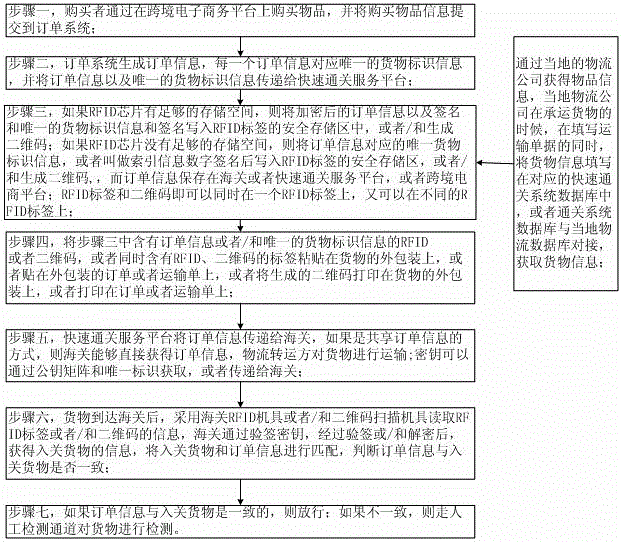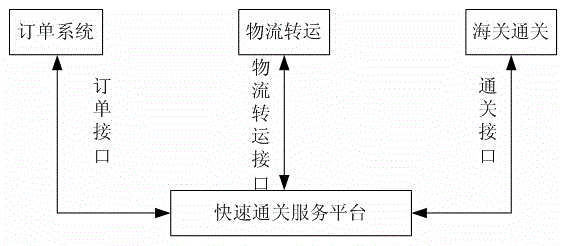Fast customs clearance method
A fast and customs technology, applied in instruments, data processing applications, logistics, etc., can solve problems such as items being stranded and unable to be dispatched immediately, and achieve the effect of avoiding false dispatch, convenient supervision, and reducing labor input.
- Summary
- Abstract
- Description
- Claims
- Application Information
AI Technical Summary
Problems solved by technology
Method used
Image
Examples
Embodiment 1
[0035] Example 1, taking cross-border e-commerce direct mail customs clearance as an example, figure 1 It is a flow chart of a fast customs clearance method, figure 2 It is a structural block diagram of a fast customs clearance method.
[0036] Such as figure 1 , 2 As shown, a quick customs clearance method includes the following steps:
[0037] Step 1: The buyer purchases items on the cross-border e-commerce platform and submits the purchased item information to the order system;
[0038] Step 2: The order system generates order information and encrypts the order information. After encryption, the order system transmits the order information to the fast customs clearance service platform through the interface between the cross-border e-commerce platform and the fast customs clearance service platform;
[0039] The specific form of encrypting the order information is: the encryption key is stored in the UKey, and the user information, product information, quantity, etc. a...
Embodiment 2
[0048] Embodiment 2, in order to prevent the ocean bill of lading from being tampered with or counterfeited, taking the ocean bill of lading as an example, the steps are as follows:
[0049] Step 1. When delivering goods, encrypt the information such as the name and quantity of the goods. The encryption key is stored in the Ukey at the delivery end, or the key is transmitted to the other party in the form of network encrypted transmission. If it is based on the combined public key The asymmetric encryption of the algorithm only needs to carry the unique identification information of the goods in the QR code;
[0050] Step 2: Print the encrypted information above on the bill of lading in the form of a QR code;
[0051] Step 3: When picking up the goods or conducting a transaction, use a terminal, such as a smartphone, to download the bill of lading signature verification app that supports the signature verification function;
[0052] Step 4: Use the bill of lading verification...
Embodiment 3
[0056] Step 1: Since it may happen that the order is not placed through the order system, or the local logistics system is not connected with the order system, or the fast customs clearance system is not connected with the order system, the item information is obtained through the local logistics company. When transporting goods, while filling in the transport documents, fill in the goods information in the corresponding fast customs clearance system database, or connect the customs clearance system database with the local logistics database to obtain the goods information; each goods information corresponds to the unique goods identification information;
[0057] Step 3, if the RFID chip has enough storage space, write the encrypted cargo information, etc., and the unique cargo identification information into the safe storage area of the RFID tag, or / and generate a two-dimensional code; if the RFID chip does not have enough storage space, the unique cargo identification info...
PUM
 Login to View More
Login to View More Abstract
Description
Claims
Application Information
 Login to View More
Login to View More - R&D
- Intellectual Property
- Life Sciences
- Materials
- Tech Scout
- Unparalleled Data Quality
- Higher Quality Content
- 60% Fewer Hallucinations
Browse by: Latest US Patents, China's latest patents, Technical Efficacy Thesaurus, Application Domain, Technology Topic, Popular Technical Reports.
© 2025 PatSnap. All rights reserved.Legal|Privacy policy|Modern Slavery Act Transparency Statement|Sitemap|About US| Contact US: help@patsnap.com


